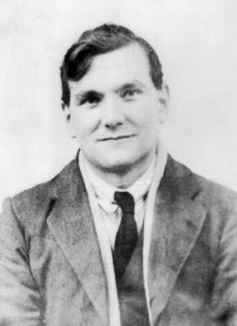Andrew Cooney was an Irish republican from Nenagh, County Tipperary, who later settled in the United States. He studied medicine at University College Dublin just as the Irish War of Independence was getting underway, and he played for a brief spell with the College's hurling club. He joined the Third Battalion of the Dublin Brigade of the Irish Republican Army (IRA) eventually being named Chief of Staff.
Stephen Hayes was a member and leader of the Irish Republican Army from April 1939 to June 1941.
Anthony Magan was an Irish republican and chief of staff of the Irish Republican Army (IRA).

Maurice Twomey was an Irish republican and the longest serving chief of staff of the Irish Republican Army (IRA).

The Irish Republican Army (IRA) of 1922–1969, an anti-Treaty sub-group of the original Irish Republican Army (1919–1922), fought against the British-backed Irish Free State in the Irish Civil War, and its successors up to 1969, when the IRA split again into the Provisional IRA and Official IRA. The original Irish Republican Army fought a guerrilla war against British rule in Ireland in the Irish War of Independence between 1919 and 1921. Following the signing of the Anglo-Irish Treaty on 6 December 1921, the IRA in the 26 counties that were to become the Irish Free State split between supporters and opponents of the Treaty. The anti-Treatyites, sometimes referred to by Free State forces as "Irregulars",A continued to use the name "Irish Republican Army" (IRA) or in Irish Óglaigh na hÉireann, as did the organisation in Northern Ireland which originally supported the pro-Treaty side. Óglaigh na hÉireann was also adopted as the name of the pro-Treaty National Army, and remains the official legal title of the Irish Defence Forces.
Jimmy Steele was an Irish republican militant. He was one of the most prominent Irish Republican Army (IRA) men in Belfast after the Irish Civil War who held practically every senior position in the Northern Command of the IRA. Later in life Steele publicly denounced the leadership of the IRA which was a prelude to the split in the IRA. Steele founded and edited several Irish Republican publications. Steele spent a large portion of his life in jails as a result of his actions against British security forces.
Seán McCaughey was an Irish Republican Army (IRA) leader in the 1930s and 1940s and hunger striker.

Daniel Keating was a lifelong Irish republican and former president of the Republican Sinn Féin. At the time of his death, he was Ireland's oldest man and the last surviving veteran of the Irish War of Independence.

Seán McCool was a prominent Irish Republican and a former chief of staff of the Irish Republican Army. Imprisoned on numerous occasions, both North and South of the border, he embarked on a number of hunger strikes in order to secure release. During the 1930s, McCool was one of the few socialists to remain in the IRA after the Republican Congress's decision to split. He stood as a candidate for the Irish Republican party Clann na Poblachta before leaving them as a result of their decision to go into government with Fine Gael.
Joe B. O'Hagan, aka J.B. O'Hagan was a Provisional IRA member.
Patrick Pearse Kelly, also known as Paul Kelso, was an Irish journalist and republican activist.
Kevin McKenna was an Irish republican and volunteer in the Tyrone Brigade and Chief of Staff of the Provisional Irish Republican Army (IRA). McKenna, a guarded, reclusive figure, was the longest-serving chief of staff of the IRA, serving from 1983 to 1997.
Thomas Harte was the first of seven Irish Republican Army (IRA) members executed by Irish forces in Mountjoy Prison and Portlaoise Prison prisons between 1940 and 1944.
Patrick MacGrath was born into an old Dublin republican family and took part in the 1916 Rising, as did two of his brothers. He was sent to Frongoch Internment Camp after the 1916 Rising and served his time there. He was a senior member of the Irish Republican Army (IRA), hunger striker, IRA Director of Operations and Training during its major bombing/sabotage in England and was the first of six IRA men executed by the Irish Government between 1940–1944. After participating in the Easter Rebellion, MacGrath remained in the IRA, rising in rank and becoming a major leader within the organisation.
Richard (Richie) Goss (1915–1941) was an executed Irish Republican and one of the few Protestant members of the Irish Republican Army (IRA) in the 1940s. Goss was a leader in a major bombing and sabotage campaign in England (1939–40).
In October 1923 mass hunger strikes were undertaken by Irish republican prisoners protesting the continuation of their internment without trial. The Irish Civil War had ended six months earlier yet the newly formed Provisional Government of the Irish Free State was slow in releasing the thousands of Irish republican prisoners opposed to the Anglo-Irish Treaty.

Jack "Sean" McNeela was a senior member of the Irish Republican Army (IRA) from Ballycroy, County Mayo, Ireland. McNeela was one of 22 Irish republicans who died on hunger-strike. As a young man, McNeela was an athlete in County Mayo and participated in Gaelic games. He came from a family of four brothers and two sisters. His brother Paddy was also active in the IRA and held the position of Quartermaster general in Dublin.

Michael Joseph Whitty was the youngest of the 22 Irish republicans who died while under on hunger strike in the 20th century. Decades after his death another Volunteer also died on 2 August during the 1981 Irish hunger strike. Volunteer Whitty fought with the IRA in the Irish War of Independence, on the Anti-Treaty side in the Irish Civil War and died while under internment by the Irish Free State government.
Seán Harrington (1912–1978) was an Irish republican who later became Chief of Staff of the Irish Republican Army.








